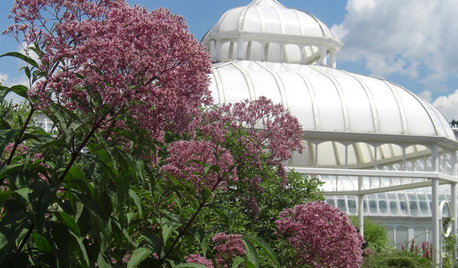butterfly weed yellowing
birkie
18 years ago
Related Stories

FLOWERSGreat Design Plant: Joe Pye Weed
This unsung beauty tolerates wet soil, provides beautiful late summer blooms and attracts butterflies and hummingbirds
Full Story
GARDENING GUIDESWhat’s in a Name? See 6 Wildflowers That Aren’t ‘Weeds’ at All
Dispel the stereotypes of weeds and try these wildlife-supporting native wildflowers in your garden
Full Story
GARDENING GUIDESGreat Design Plant: Butterfly Milkweed, a Beacon in the Prairie
Vivacious orange flowers for you, nectar for the butterflies and bees. Asclepias tuberosa is worth planting for more reasons than one
Full Story
GARDENING GUIDES6 Plants That Beat Butterfly Bush for the Wildlife Draw
It's invasive, a nonnative and a poor insect magnet. Check out these better alternatives to butterfly bush in the garden
Full Story
GARDENING GUIDES20 Favorite Flowers for Butterflies and Bouquets
Discover perennials and annuals that do double duty as butterfly magnets and versatile cut flowers
Full Story
GARDENING FOR BUTTERFLIESBe a Butterfly Savior — Garden for the Monarchs
Keep hope, beauty and kindness alive in the landscape by providing a refuge for these threatened enchanters
Full Story
GARDENING GUIDES6 Steps to Creating Your Butterfly Garden
Encourage these fanciful winged beauties to visit your garden while helping restore their fragmented habitat
Full Story
GARDENING FOR BUTTERFLIESButterfly Gardening: Delight the Eyes With Living Sculptures
Surprise and thrill with a garden that attracts magical winged creatures, bringing color, movement and life
Full Story
CALIFORNIA NATIVE PLANTSGreat Design Plant: Asclepias Is Attractive to Monarch Butterflies
Increase monarch butterfly populations in California by planting stunning native milkweeds
Full Story
EDIBLE GARDENSNatural Ways to Get Rid of Weeds in Your Garden
Use these techniques to help prevent the spread of weeds and to learn about your soil
Full StorySponsored
Your Custom Bath Designers & Remodelers in Columbus I 10X Best Houzz






john_mo
birkieOriginal Author
Related Professionals
Middle Island Landscape Architects & Landscape Designers · Woodinville Landscape Architects & Landscape Designers · Frisco Landscape Contractors · Edmond Landscape Contractors · Chelmsford Landscape Contractors · Dickinson Landscape Contractors · Euclid Landscape Contractors · Hayward Landscape Contractors · Paso Robles Landscape Contractors · Shirley Landscape Contractors · Soddy Daisy Landscape Contractors · Freehold Decks, Patios & Outdoor Enclosures · Garden City Decks, Patios & Outdoor Enclosures · Lauderdale Lakes Decks, Patios & Outdoor Enclosures · Lincoln Decks, Patios & Outdoor Enclosuresladyslppr
birkieOriginal Author
vera_eastern_wa
birkieOriginal Author
sstaley1_verizon_net
cactusgarden
terryr
cactusgarden
terryr
cactusgarden
terryr